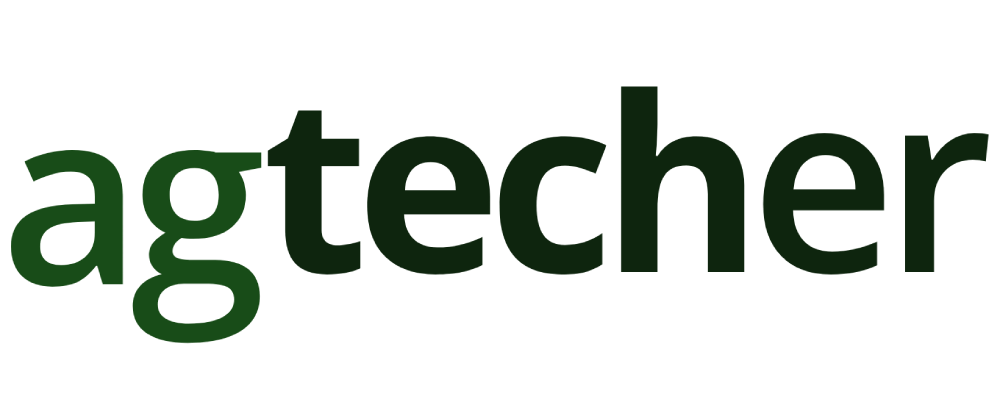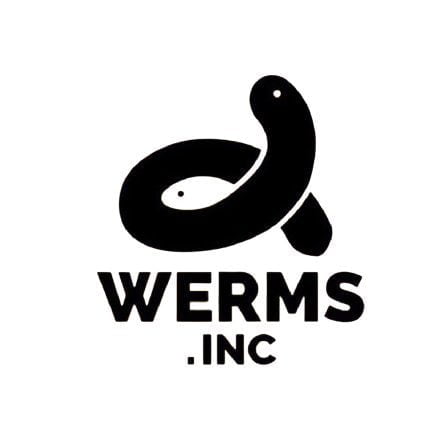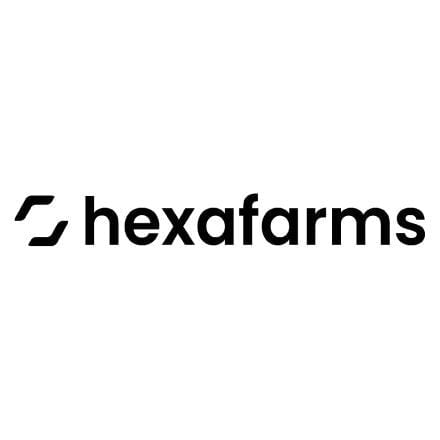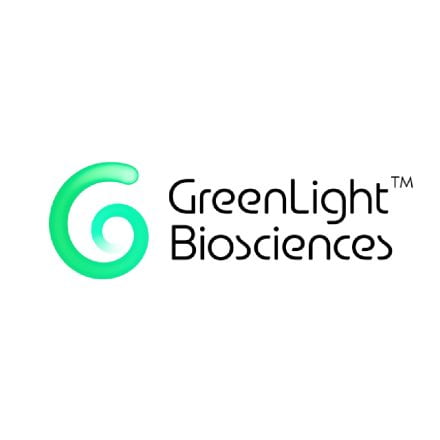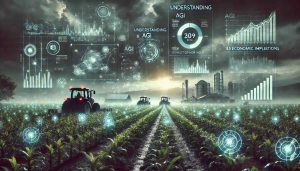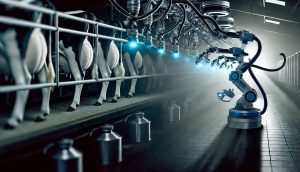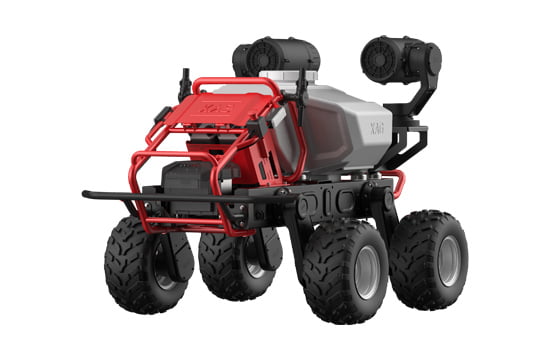Modern agriculture has developed significantly in recent decades. A prominent example of these developments are themilking robots, which are increasingly being used on farms today. This intelligent milk production allows farmers to automate the milking process and thus overcome many of the challenges of traditional methods. Through the use of robotic milking systems, we are experiencing a revolution in livestock technology.
Imagine how your daily routine would look if the milking of your cows were fully automated. Barn automation not only reduces human labor but also leads to greater precision in monitoring cow health. With advanced sensor technology in agriculture, key health indicators can be continuously recorded and analyzed. This smart system helps to detect problems early and take timely actions.
Automated milking systems offer numerous advantages over traditional milking methods. The remarkable capacity to efficiently process large quantities of high-quality milk without compromising cow health is a significant advancement for modern agriculture. At the same time, a data-driven cow management system provides valuable insights into dairy efficiency improvement. All this together is a strong argument for the increased use of such agricultural technologies in today’s Milk Production 4.0.
- Milking robots automate the milking process and significantly reduce human labor.
- Sensor technology continuously monitors cow health and milk quality, enabling early problem detection.
- Barn automation offers flexibility and improves animal welfare through self-determined milking times for cows.
- Data management systems analyze collected data to optimize milk production.
- Long-term savings and efficiency gains justify the high investment costs of milking robots.
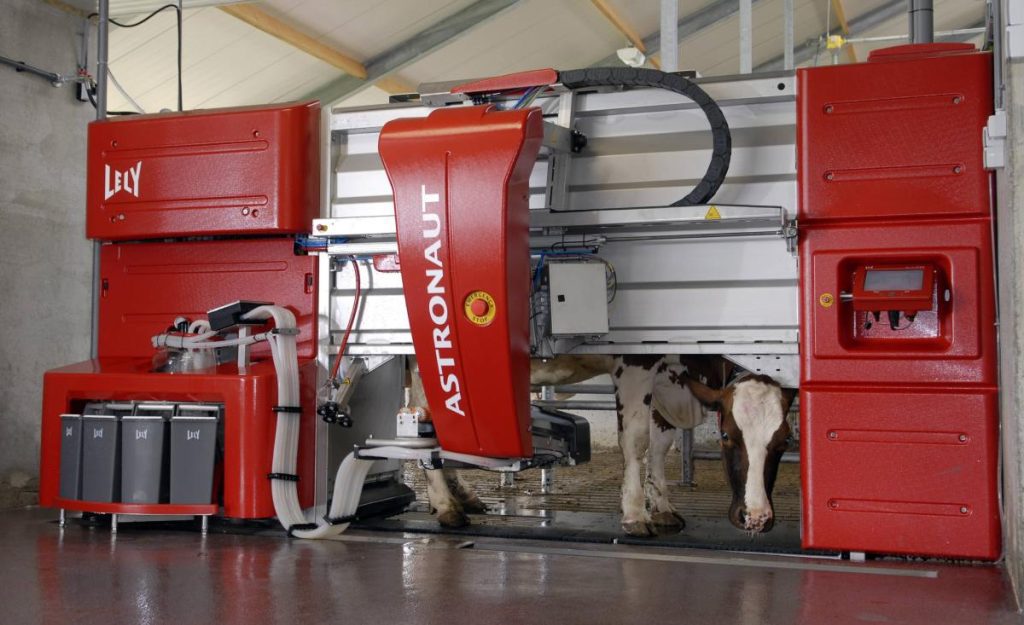
Copyright Lely
Function and Use of Milking Robots
Milking robots are modern devices that are increasingly used in automated agriculture. They take over the milking of cows and offer a variety of advantages compared to traditional milking methods. By using robotic milking systems, the process is fully automated, saving time and reducing workload.
The technology is based on a combination of sensor technology in agriculture, cameras, and robotics. The robot automatically detects and cleans the cow’s teats before attaching the milking equipment. This achieves a high level of dairy efficiency improvement. Throughout the process, sensors continuously monitor various parameters such as milk quantity and quality, as well as the health of the animals.
Another advantage is the flexibility for the cows. They can independently decide when they want to be milked, which leads to higher satisfaction and better well-being. Modern agricultural technologies also enable the collected data to be analyzed by the cow management system. This promotes data-driven decision-making and improves the monitoring of cow health.
Thanks to these advanced systems, farmers benefit not only from increased yields but also from improved animal care and optimization of overall barn automation. Ultimately, these developments lead to more efficient and smarter milk production.
Read more about innovative farming: An introduction to Insect Farming or “Insect AG”
Advantages Over Traditional Milking Methods
Robot-assisted milking technology: This technology brings many advantages compared to traditional milking methods. Firstly, it offers greater flexibility for farmers, as milking robots can work around the clock. No more fixed milking times mean less stress for both you and your cows.
Another major advantage is the precision and consistency with which milking robots operate. While manual milking can vary from person to person, automated milking systems always deliver consistent results. This contributes to the increase in dairy efficiency.
Milking robots are also equipped with sensor technology in agriculture that constantly monitors the health status of the cows. This leads to early detection of diseases or other health issues, enabling faster intervention.
New technologies such as the intelligent milk production system allow for individual cow management systems and offer precise data-driven animal care. Another benefit is the reduction of physical labor. With automated feeding systems and robotic milking systems, you need less direct physical work.
In summary, robot-assisted milking technology offers numerous advantages over traditional methods. These range from higher efficiency and better animal health to better use of agricultural technology and modern agricultural technologies. Together, these advantages help elevate your Milk Production 4.0 to a new level.
Discover world leader Lely and their products.
“The future of agriculture lies in the use of advanced technologies that combine efficiency and sustainability.” – Dr. Markus Keller, Agritechnology Expert
| Category | Description | Technology | Benefits | Examples | Challenges |
|---|---|---|---|---|---|
| Milking Automation | Automated milking at optimal times | Milking robots | Increased efficiency | Lely Astronaut | High initial investment |
| Sensor-based Monitoring | Continuous monitoring of cow health | Integrated sensors | Early problem identification | GEA Farm Technologies | Technical maintenance |
| Real-time Data Analysis | Analysis of health and performance data | Analysis software | Optimized feeding | DeLaval VMS V300 | Data privacy and security |
| Milk Quality | Gentle and clean milking | Automated systems | Reduced contamination | Fullwood Packo | Regular inspections |
| Workload | Reduction of manual tasks | Automation software | Less physical strain | Robotic milking systems | Staff training |
| Integration into Existing Systems | Integration into farm management systems | Management platform | Increased overall productivity | Pasture.io | Compatibility issues |
Technological Advances in Milking Robots
In recent years, milking robots have developed tremendously. A significant advancement is the integration of sensor technology in agriculture. These sensors continuously monitor cow health and provide important data to the cow management systems. Thanks to this technology, farmers can respond to health issues in a timely manner.
Another highlight is modern barn automation solutions. These allow robotic milking systems to be seamlessly integrated with other automated systems, such as feeding systems. The resulting intelligent milk production leads to improved coordination and increased milk yield.
The user-friendliness has also greatly improved. Earlier models often required extensive training and manual intervention. Today’s milking robots are easier to operate and have intuitive interfaces that display important information immediately.
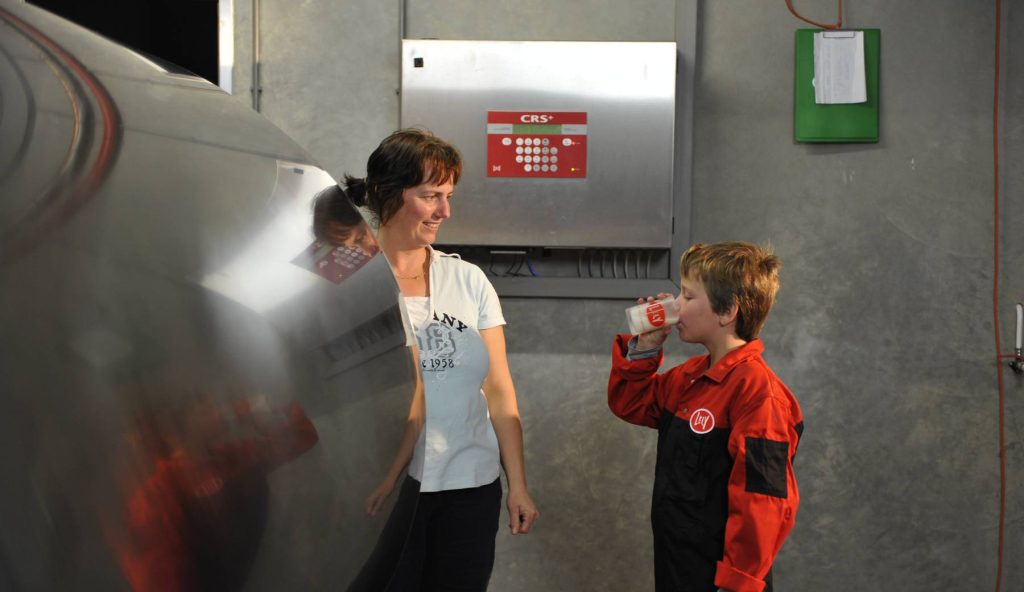
copyright Lely
These technological improvements not only lead to increased dairy efficiency but also promote animal welfare. Data-driven animal care ensures that each cow is optimally cared for. Milking robots significantly contribute to modern agricultural technologies and sustainably revolutionize livestock technology.
The continuous development of agritechnology offers exciting prospects for the future of Milk Production 4.0. Thanks to innovative technologies, agricultural operations can further optimize their processes while improving the conditions for their animals.
Complete Product Overview of Robot-assisted Milking Technology
Maintenance and care of milking robots are crucial aspects of modern agricultural technologies. Regular maintenance ensures that automated milking systems always operate efficiently and minimize downtime.
Maintenance and Care of Milking Robots
Thorough cleaning of the milking robot after each use is important to maintain hygiene in the barn. It is essential to ensure that all milk lines, cups, and sensors are thoroughly cleaned. To ensure optimal performance, it is advisable to regularly check and adjust the various cow management systems and their settings.
The mechanical parts of the milking robots also need attention. It is recommended to regularly lubricate moving components such as arms and joints and check for wear and tear. Early detection of signs of wear can avoid costly repairs and contribute to long-term functionality.
Besides the mechanical aspects, software maintenance also plays an important role. Updating the software ensures that the system is always up to date with the latest technology and that all functions can be optimally used. The integration of sensor technology in agriculture is particularly important to collect precise data for data-driven animal care.
In summary, regular maintenance and care not only contribute to the extended lifespan of milking robots but also to the optimization of the entire Milk Production 4.0.
| Parameter | Manual Milking Methods | Milking Robots | Advantage | Flexibility | Technical Effort |
|---|---|---|---|---|---|
| Labor Requirement | High | Low | Less personnel needed | Fixed times | Basic knowledge required |
| Precision | Variable | High | Consistent milking quality | Inflexible | Advanced knowledge required |
| Monitoring Cow Health | Manual | Automated by sensors | Early detection of problems | Rigid | Combination of hardware and software |
| Milking Frequency | Limited | Individual | Optimal milking frequency for each cow | Unchangeable | High degree of automation |
Costs and Economic Efficiency of the Systems
An important aspect when purchasing milking robots is the analysis of costs and economic efficiency. Initially, the financial outlay for automated milking systems may seem high, but significant savings can be achieved in the long run.
Robotic milking systems offer a significant reduction in labor costs, as manual tasks are eliminated. Additionally, established agricultural technologies allow for a more precise increase in dairy efficiency. This increases the yield per cow and thus maximizes the profitability of the operation.
When considering economic efficiency, factors such as barn automation and data-driven animal care also play a role. Modern livestock technology not only improves animal health (e.g., through cow health monitoring) but also the quality control of milk production.
Another advantage is the continuous performance improvement. Advanced sensor technology in agriculture allows for early detection and correction of weaknesses, which in turn minimizes downtime. Finally, a good cow management system helps to optimize resource use and reduce production costs.
Overall, these systems represent a significant investment, but due to their numerous advantages in modern agricultural technologies, they offer an attractive solution for optimizing Milk Production 4.0.
Animal Welfare and Hygiene in Milking Robots
The welfare of animals and hygiene are crucial aspects when using milking robots in modern agricultural technology. Using robotic milking systems creates a stress-free environment for cows as they can decide when they want to be milked. This positively impacts their health and behavior.
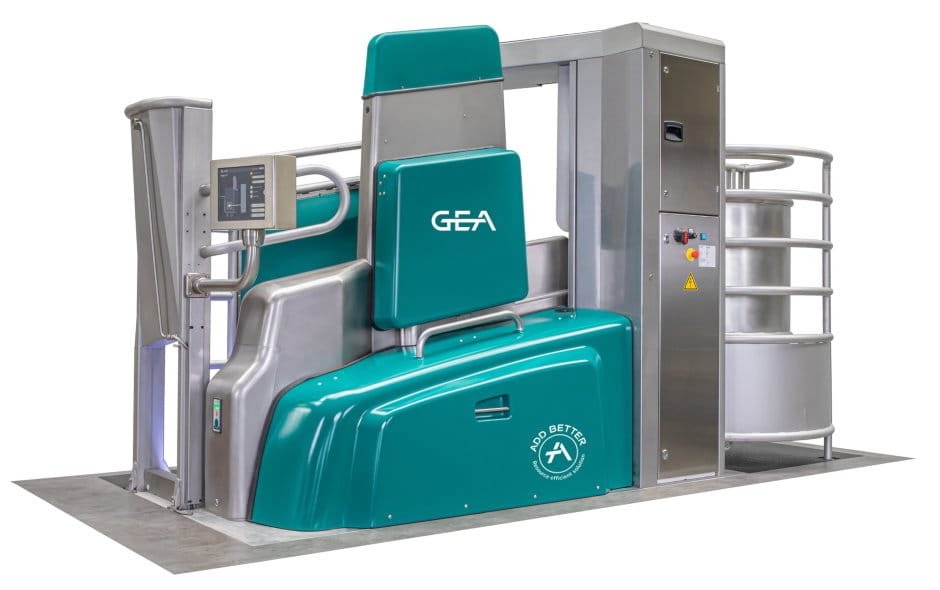
GEA DairyRobot R9500
Another advantage is the constant and thorough cleaning of milking equipment, which significantly reduces the risk of infections. The sensor technology in agriculture enables the milking robots to individually recognize each cow and continuously monitor their health status. This leads to data-driven animal care, where deviations in health status are quickly detected and actions are taken.
Moreover, automated systems contribute to improving milk quality by ensuring that each milking is conducted under hygienic conditions. Continuous monitoring and evaluation of data by cow management systems provide valuable insights into cow health and milk yields. Overall, these technologies help promote both dairy efficiency and animal welfare.
Data Management and Analysis in Milking Technology
Modern agricultural technology has reached a new dimension with the introduction of intelligent milk production and data-driven animal care. Particular attention is paid to data management and analysis in milking technology.
Milking robots continuously collect data on the health and performance of each individual cow. Sensors in the systems, such as in automated milking equipment, gather information on milk yield, milk quality, and even indications of diseases.

GEA DairyRobot R9500
This collected data is then processed and analyzed in a cow management system. Livestock technology allows farmers to implement targeted measures to improve Milk Production 4.0.
A major advantage here is the continuous monitoring of the herd. Sensor technology in agriculture enables early detection and resolution of issues. This not only increases dairy efficiency but also the well-being of the animals.
Barn automation and automated feeding systems perfectly complement these technologies. Farmers get a comprehensive view of their operational processes and can make informed decisions.
In summary, data-driven analysis enables precise control of production processes, better cow health monitoring, and ultimately optimized results in milk production.
Future Trends in Robot-assisted Milking Technology
Looking to the future of robot-assisted milking technology, numerous exciting innovations and developments are expected. A central trend is the increasing integration of artificial intelligence (AI) in milking robot systems. This technology allows devices to continuously learn and adapt to new situations and conditions, leading to optimized dairy efficiency.
Another interesting development is the increasing connectivity of systems within a farm. By linking sensor technology in agriculture with robotic milking systems, fully connected and automated barn environments are created. This also includes integration with feeding systems and cow management systems, enabling even more precise control and optimization of animal care.
Additionally, technologies for cow health monitoring are becoming increasingly important. Modern sensors can capture and analyze vital data such as heart rate, temperature, and movement patterns of cows. This allows for precise monitoring of individual animal health and early response to potential diseases.
Finally, the increasing use of data-driven analysis systems offers many opportunities for intelligent milk production. These systems collect and process large amounts of data to provide detailed insights into Milk Production 4.0, ultimately promoting more efficient and profitable agriculture.
